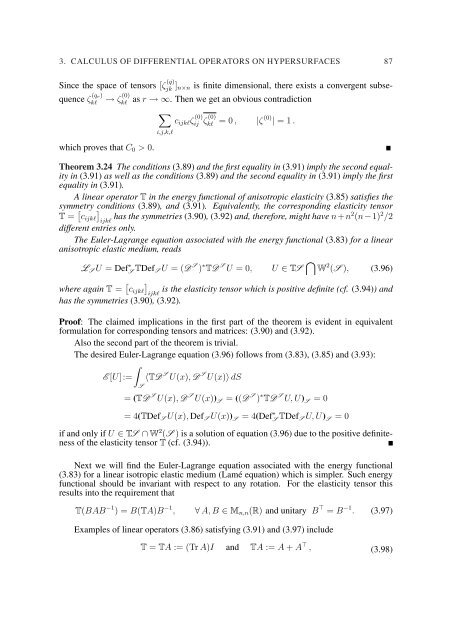EQUATIONS OF ELASTIC HYPERSURFACES
EQUATIONS OF ELASTIC HYPERSURFACES
EQUATIONS OF ELASTIC HYPERSURFACES
Create successful ePaper yourself
Turn your PDF publications into a flip-book with our unique Google optimized e-Paper software.
3. CALCULUS <strong>OF</strong> DIFFERENTIAL OPERATORS ON <strong>HYPERSURFACES</strong> 87<br />
Since the space of tensors [ζ (q)<br />
jk ] n×n is finite dimensional, there exists a convergent subsequence<br />
ζ (q r)<br />
kl<br />
→ ζ (0)<br />
kl<br />
as r → ∞. Then we get an obvious contradiction<br />
∑<br />
c ijkl ζ (0)<br />
ij ζ(0) kl<br />
= 0 , |ζ (0) | = 1 .<br />
which proves that C 0 > 0.<br />
i,j,k,l<br />
Theorem 3.24 The conditions (3.89) and the first equality in (3.91) imply the second equality<br />
in (3.91) as well as the conditions (3.89) and the second equality in (3.91) imply the first<br />
equality in (3.91).<br />
A linear operator T in the energy functional of anisotropic elasticity (3.85) satisfies the<br />
symmetry conditions (3.89), and (3.91). Equivalently, the corresponding elasticity tensor<br />
T = [ c ijkl<br />
]ijkl has the symmetries (3.90), (3.92) and, therefore, might have n+n2 (n−1) 2 /2<br />
different entries only.<br />
The Euler-Lagrange equation associated with the energy functional (3.83) for a linear<br />
anisotropic elastic medium, reads<br />
L S U = Def ∗ S TDef S U = (D S ) ∗ TD S U = 0, U ∈ TS ⋂ W 2 (S ), (3.96)<br />
where again T = [ c ijkl is the elasticity tensor which is positive definite (cf. (3.94)) and<br />
]ijkl<br />
has the symmetries (3.90), (3.92).<br />
Proof: The claimed implications in the first part of the theorem is evident in equivalent<br />
formulation for corresponding tensors and matrices: (3.90) and (3.92).<br />
Also the second part of the theorem is trivial.<br />
The desired Euler-Lagrange equation (3.96) follows from (3.83), (3.85) and (3.93):<br />
∫<br />
E [U]:= 〈TD S U(x), D S U(x)〉 dS<br />
S<br />
= (TD S U(x), D S U(x)) S = ((D S ) ∗ TD S U, U) S = 0<br />
= 4(TDef S U(x), Def S U(x)) S = 4(Def ∗ S TDef S U, U) S = 0<br />
if and only if U ∈ TS ∩ W 2 (S ) is a solution of equation (3.96) due to the positive definiteness<br />
of the elasticity tensor T (cf. (3.94)).<br />
Next we will find the Euler-Lagrange equation associated with the energy functional<br />
(3.83) for a linear isotropic elastic medium (Lamé equation) which is simpler. Such energy<br />
functional should be invariant with respect to any rotation. For the elasticity tensor this<br />
results into the requirement that<br />
T(BAB −1 ) = B(TA)B −1 , ∀ A, B ∈ M n,n (R) and unitary B ⊤ = B −1 . (3.97)<br />
Examples of linear operators (3.86) satisfying (3.91) and (3.97) include<br />
T = TA := (Tr A)I and TA := A + A ⊤ , (3.98)

















